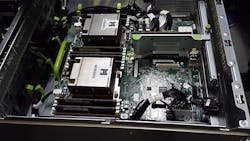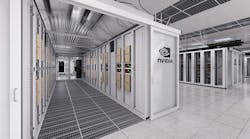We live in a sea of data. Today, almost every aspect of our lives is already intertwined with some type of data generating engine. This will be even more impactful for future generations as we become a persistently connected society operating in a data-driven world. Cognitive systems, and new concepts like learning engines will become a part of our everyday lives.
Machine learning, natural language processing, and artificial intelligence (AI) are all designed to transform data from simple pieces of our lives into cognitive components. Ultimately, helping us make better decisions, stay more competitive, and impact strategic direction. An example: I recently wrote about becoming a “cloud-powered” parent. It’s been just over a month since I’ve become a new dad, and I’ve been leveraging smart tools, data analytics, and patterns to provide detailed analysis around every detail of our baby’s life. And you know what? It really does help.
Recently, IDC estimates that the amount of the global datasphere subject to data analysis will grow by a factor of 50 to 5.2 zettabytes in 2025; the amount of analyzed data that is “touched” by cognitive systems will grow by a factor of 100 to 1.4 zettabytes in 2025!
So it’s really important to understand the core components behind these cognitive systems. AI is a great place to start.
AI: What It is & How to Use It
So what exactly is AI? Artificial intelligence engines allow machines to learn through various types of data gathering, inputs, and even experience to perform human-like tasks. These technologies rely on things like natural language processing and machine learning as well as deep learning to work. We’ll touch on that in a second.
There are already a lot of use cases. Some examples:
- AI helps with repetitive learning and task automation. You may have heard of the term robotic process automation (RPA), but AI is quite different. As opposed to just doing the same task, like supporting back-office functions, AI introduces variability and the ability to adapt to changing business environments. Although a bit more human interaction is required, you’re capable of supporting much more complex tasks with an AI engine.
- AI helps add a deeper layer of intelligence. You can do so much with an AI engine. Maybe you want to build a chat bot, or you need an interactive system to work with level 1 support. AI can help maintain these types of architectures and allow them to become self-functioning. As data continues to increase, AI is capable of analyzing this information and turning it into usable insights for a variety of purposes. For example, security analytics, financial services, and even healthcare service delivery.
- AI is adaptive, and “evolves” through learning algorithms. This part is really cool. By gathering data and finding patterns within the structure of that data, an AI engine can learn. Think of an AI engine that taught itself to play chess. Similarly, when there is enough data, patterns, and behaviors to analyze, an AI engine can become a predictive tool. For example, what should you sell online next? AI could also be used to adjust a financial model based on market circumstances that humans couldn’t even see.
- AI can integrate with data warehouses. Data warehouses allow you to store vast amounts of information on an intelligent platform. Please note, a data warehouse is not a traditional database. Although both are relational systems, data warehousing integrates with vast amounts of data for the specific purpose of analytics and even data mining. From there, AI engines can tap into these systems to create new learning models and help you visualize data. Basically, it’s AI coupled with the power of big data.
- AI can help increase accuracy between user and customer. And even business interactions and security. AI will analyze data patterns and evolve along with the structure of your organization. From there, it can detect anomalies and report them before it even becomes an issue. Security aside, AI can analyze images, for example, and fine-tune the results. Imagine an AI engine that can scan a radiology report or an MRI. It can reduce “noise” in the image and result and give doctors unprecedented perspective into what they’re seeing.
Now, you have things like machine learning and natural language processing. To keep it relatively brief, machine learning is a key data analytics function that helps automate data analytics modeling. It’s a core branch of AI and helps learn data, identify patterns, and help make better decisions with very little human interaction.
The Power of Natural Language Processing
The other really interesting component is natural language processing (NLP). Personally, I find this one very interesting. NLP allows you to create intelligent interactions between machines and humans. To fill the gap between people and machines, NLP leverages code, computational linguistics, and even computer science to help understand and even manipulate human language. There’s a really fun, and simple example of this.
I recently downloaded an app called theMind. If you want to play around with NLP, this is your chance. Basically, NLP allows you to insert almost any kind of data to get an end result. In the case of theMind, you can ask the world any question you want, anonymously, and get insight back on that topic instantly. Here’s the key, there’s no limitation as to what your answer can be. It can be a number, it can be one word, it can be a sentence, or it can be an entire book. The NLP engine aggregates the results, is able to filter through the response to give the result as a truly unbiased opinion based on your question.
I know it’s a lot to grasp; but let’s quickly dive into architecture and how to get started with AI.
- Consider your infrastructure (you have options!). You actually have a few options here. You can go with an on-premise solution, one that’s solely in the cloud, and one that’s hybrid. For example, recently Pure Storage and NVIDIA released a powerful, advanced analytics engine called AIRI as an AI-ready infrastructure to enable data architects, scientists, and business leaders. This kind of architecture is designed to enable data architects and scientists to deliver time-to-insight in minutes to hours, rather than weeks to months. Of course, there are cloud options as well. Microsoft Azure Machine Learning, Google AI, and Machine Learning on AWS are just a few examples of powerful AI engines that are cloud-based. From there, you can integrate APIs so that developers can leverage applications, various data points, and even support a broad framework for their data science needs.
- Understand your data sources. This is going to take some research. Is your data structured and processed? Or, is it semi-structured, unstructured, or even raw? Also, what’s creating your data? Is it users, laptops, or IoT devices? All of these concepts matter as you design your own AI architecture and landscape. This next part is important. A data source exploration can be exhausting and very challenging. Please don’t do this on your own. There’s a good chance you’ll miss a key repository or not include data that should be included. Work with an organization that can lend you a data scientist or two to help you map out your data effectively.
- Know your use-case. This is arguably the hardest part. How do you even know if you have a use-case for AI? It’s been business as usual, you’re doing well … so you really need to invest in an AI engine? Well, healthcare, manufacturing, hospitality, education, financial services, and even governments are all investing in AI to help them make better decisions. Sometimes you won’t know if you have a use-case until you ask the right questions. Oftentimes, you’ll need to review your own business strategies and initiatives. Remember, innovation is enabled by the pace of your technology. And, AI systems can really help accelerate that process. I mentioned a few use-cases earlier. Consider those as well as other as you start on your AI journey.
If you’re this far and it’s still all confusing; you’re not alone. Capturing the benefits of AI can be a challenge.
One of my biggest recommendations is that you do not need to go it alone. That’s one great reason why data scientists and AI architects are a booming profession. Even if you don’t quite understand your use case, asking questions about the potential of AI and your own data requirements is a great start. Don’t let your data collect digital dust. There are some really powerful use cases and scenarios where an AI engine can really help you out.






